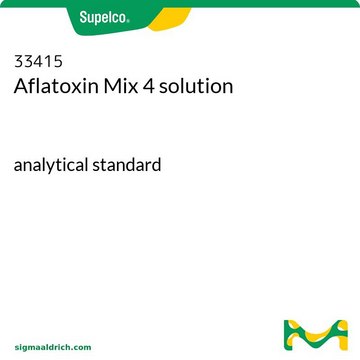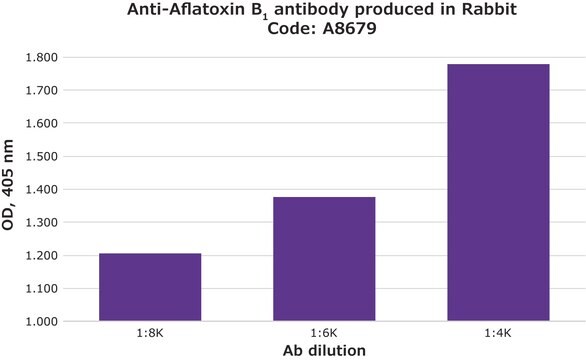推荐产品
品質等級
儲存溫度
2-8°C
一般說明
Aflatoxin is the most common food toxin that is harmful to human and animal health. The most frequent aflatoxins are B1, B2, G1, and G2, which can affect the body through respiratory, mucosal, or cutaneous routes, causing an excessive inflammatory response. Aflatoxin can infect crops during their growing stages or even after they are harvested. It mainly targets the liver and can impair the effectiveness of immunization in children, increasing the risk of infection. Aflatoxin detection and quantification in food and feed is a critical part of food and feed safety concerns. The absorption and emission spectra of aflatoxins are commonly used to detect and identify them, with the highest absorbance occurring at 360 nm. Aflatoxin is frequently degraded, mitigated, and managed using a variety of treatments, including chemical, physical, and biological approaches.
Aflatoxins are hepatotoxic metabolites. They are produced by molds, such as, Aspergillus flavus and Aspergillus parasiticus. They are naturally found poisonous carcinogens and the most widely known mycotoxins.
包裝
Four aflatoxins from Aspergillus flavus
相關產品
产品编号
说明
价格
訊號詞
Danger
危險分類
Acute Tox. 1 Dermal - Acute Tox. 1 Oral - Acute Tox. 2 Inhalation - Carc. 1B - Muta. 1B - Repr. 2
儲存類別代碼
6.1A - Combustible acute toxic Cat. 1 and 2 / very toxic hazardous materials
其他客户在看
Review of past and present research on Aflatoxin in Uganda
Sittig's Handbook of Toxic and Hazardous Chemicals and Carcinogens (2008)
Review of past and present research on Aflatoxin in Uganda
Sittig's Handbook of Toxic and Hazardous Chemicals and Carcinogens (2008)
Review of past and present research on Aflatoxin in Uganda
Kaaya NA and Warren HL
African Journal of Food, Agriculture, Nutrition and Development, 5(1) (2005)
Production of aflatoxin on rice
Shotwell OL, et al.
Applied Microbiology, 14(3), 425-428 (1966)
我们的科学家团队拥有各种研究领域经验,包括生命科学、材料科学、化学合成、色谱、分析及许多其他领域.
联系技术服务部门












